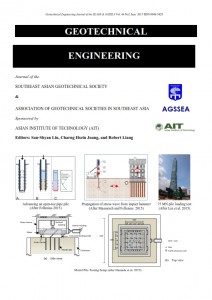Analysis of Results of an Instrumented Bidirectional-Cell Test
Main Article Content
Abstract
The bidirectional-cell test has been around since the early 1970s. The first commercial development came about in the early 1980s in Brazil and about a decade later in the USA. The use of strain-gage instrumented tests was pioneered by the US supplier of the test method. The results of a bidirectional-cell test on a strain-gage instrumented 1.2 m diameter, 40 m long, bored pile were analyzed to establish the load distribution in the test pile, the distributions of beta-coefficient along the test pile, and the unit shaft shear resistance versus movement relative to the soil. The response to the applied load was modeled in an effective stress analysis to determine the t-z and q-z functions, as fitted to the measured upward and downward curves. The equivalent pile head-down load-distribution was modeled from the functions, including the separate modeling of the pile response for the pile head, pile shaft, and pile toe. The calculated pile head loadmovement curve was compared to a load-movement curve manually calculated directly from the test data.
Article Details

This work is licensed under a Creative Commons Attribution-NonCommercial-NoDerivatives 4.0 International License.
Copyright © 2019 Association of Geotechnical Societies in Southeast Asia (AGSSEA) - Southeast Asian Geotechnical Society (SEAGS).


